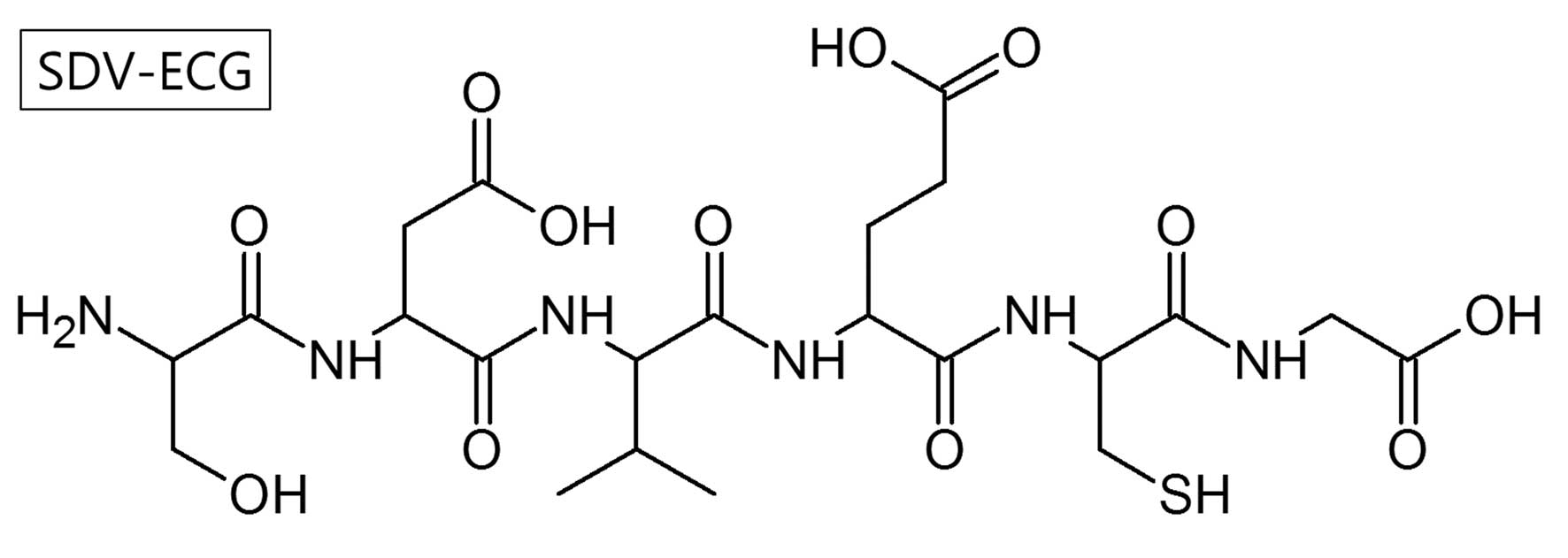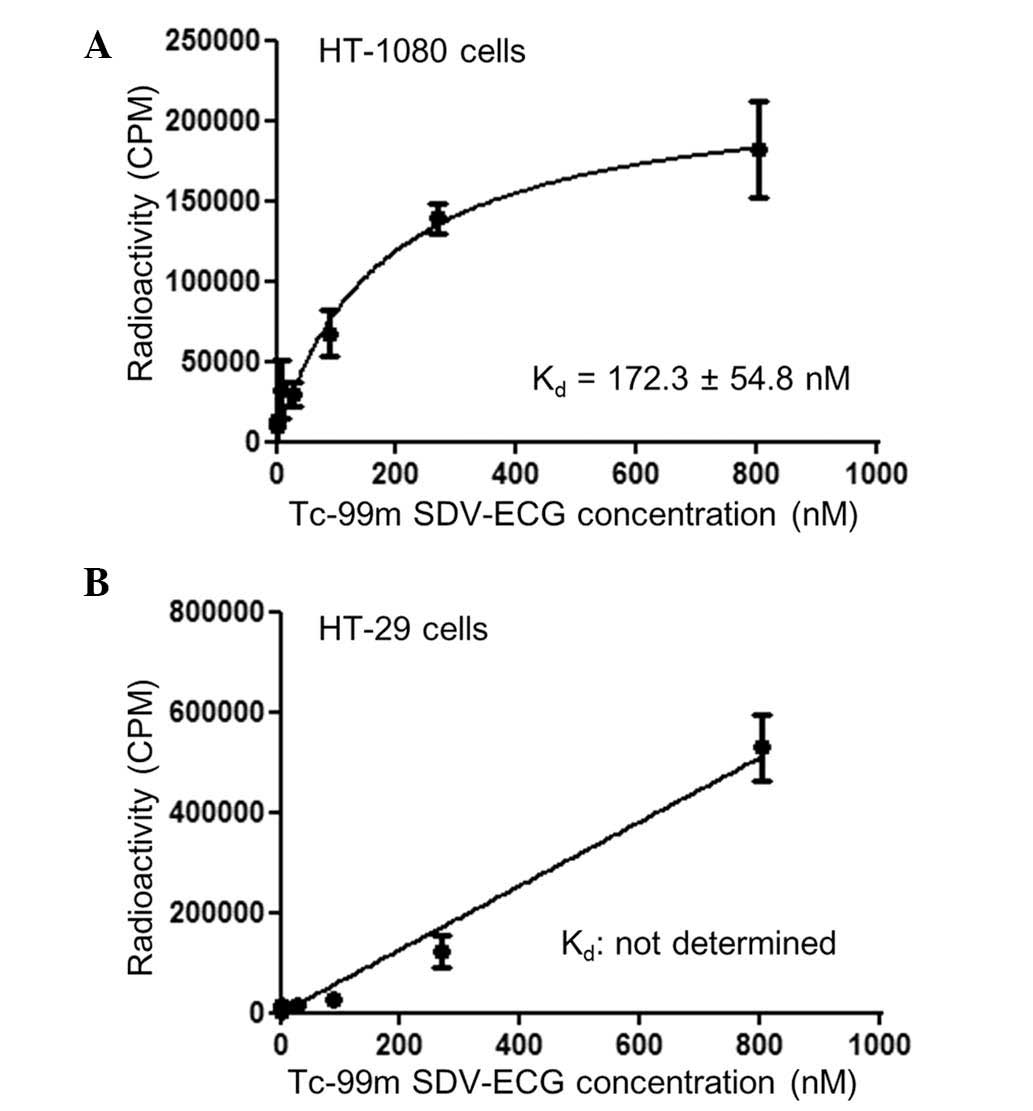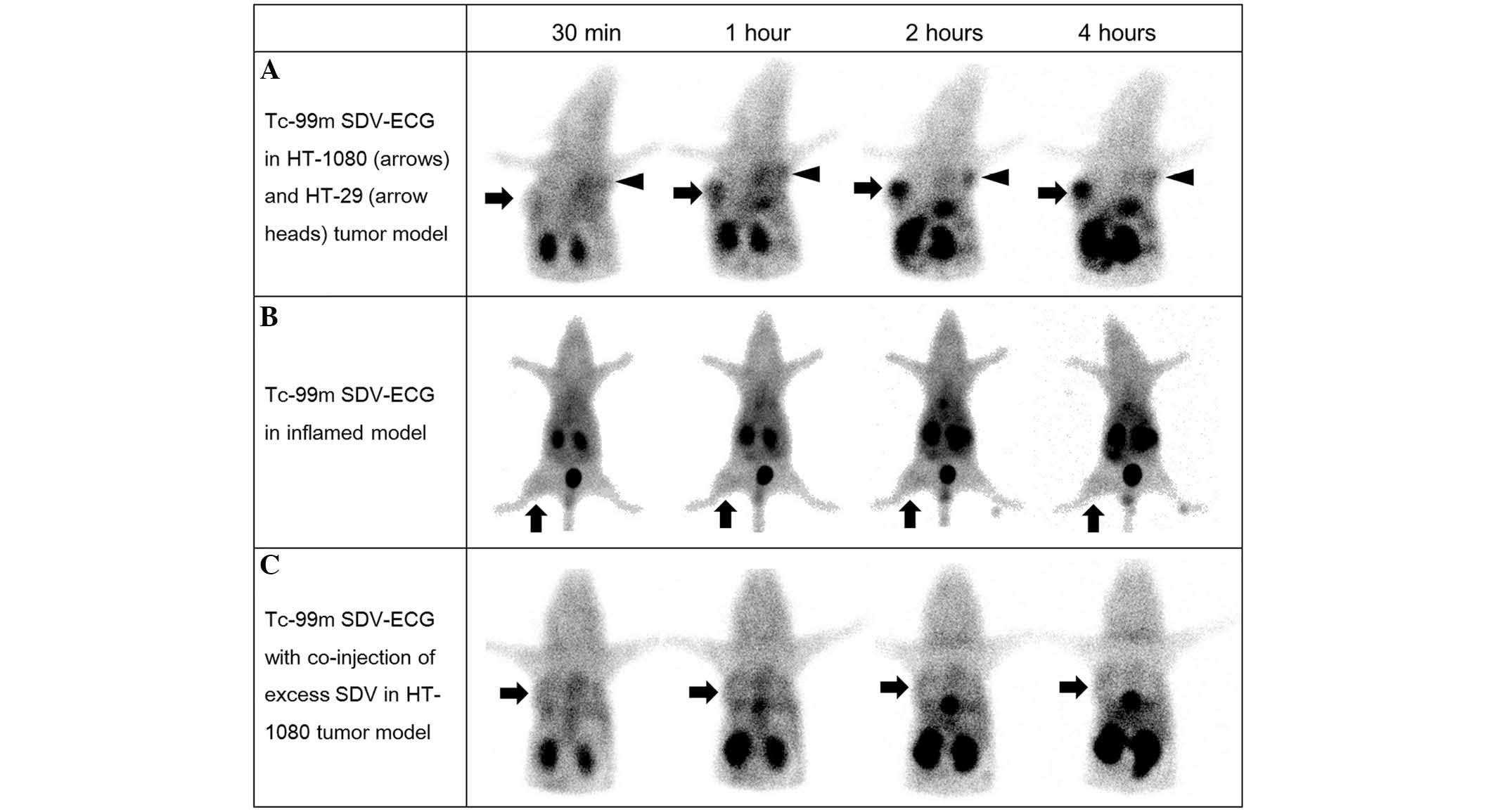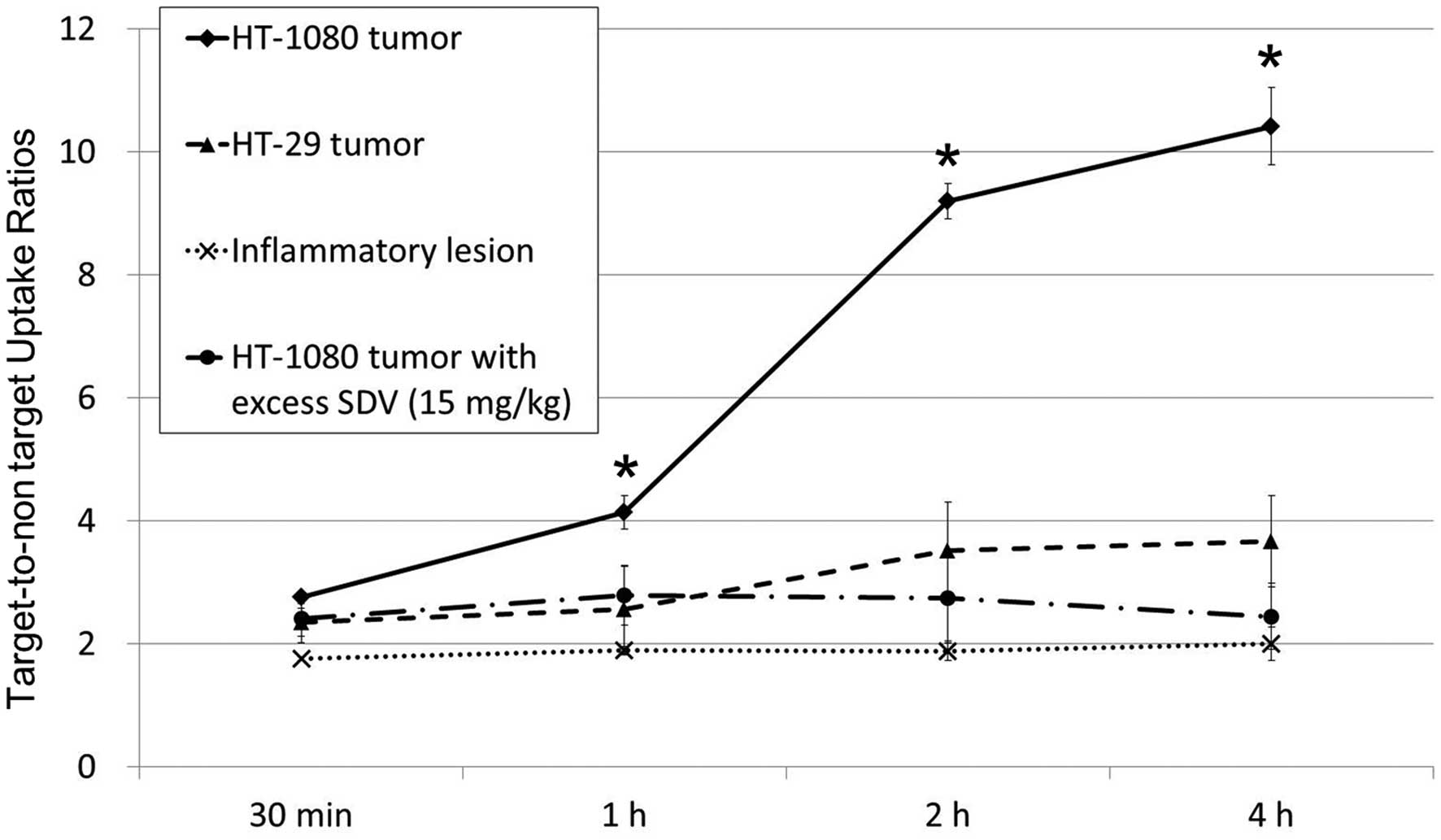Tc‑99m Ser‑Asp‑Val‑Glu‑Cys‑Gly: A novel Tc‑99m labeled hexapeptide for molecular and non‑invasive tumor imaging
- Authors:
- Published online on: October 6, 2016 https://doi.org/10.3892/mmr.2016.5811
- Pages: 4887-4892
Abstract
Introduction
Angiogenesis is one of the characteristics of tumor progression and it has been regarded as essential for tumor growth and metastasis (1). A number of proteins are not expressed, or are expressed at low levels, by the endothelium of normal blood vessels that are upregulated in angiogenic blood vessels of the tumor, including integrin αvβ3 (2), vascular endothelial growth factor receptor (3), and aminopeptidase N (4). Numerous peptides, such as arginine-glycine-aspartic acid (RGD), glutamic acid-leucine-arginine and asparagine-glycine-arginine, have been reported and evaluated (2,5,6).
Lee et al (7) identified a novel peptide sequence containing serine-aspartic acid-valine (SDV) using the ProteoChip-based screening system (7). In their subsequent studies, SDV peptide was demonstrated to bind specifically to the same binding site (integrin αvβ3) as RGD peptide, and induce upregulation of tumor protein p53 in human umbilical vein endothelial cells (8,9). Despite the desirable specific binding of SDV peptide to integrin αvβ3, there have been no previous efforts to develop an imaging agent for tumors using the SDV sequence. Molecular imaging targeted to angiogenesis has potential for clinical use, and as a research tool in tumor biology and in the development of therapeutic agents.
Accurate distinguishing of cancer and inflammation is important for cancer diagnosis. Due to the overlap of biochemical and imaging features, differentiation of an inflammation from malignancy using conventional computed tomography can be difficult (10). The diagnostic accuracy of F-18 fluorodeoxyglucose (FDG) positron emission tomography (PET) has been also compromized by acute inflammatory diseases, including tuberculosis, pneumonia, and sarcoidosis (11,12). Novel tumor imaging agents discriminating malignancy from benign inflammation may provide improved patient management in a clinical setting.
The present study successfully developed technetium-99m SDV-glutamic acid-cysteine-glycine (ECG) to target the integrin αvβ3 of tumor cells. Furthermore, the diagnostic performance of Tc-99m SDV-ECG as a tumor molecular imaging agent was evaluated in the murine model. Furthermore, the potential of Tc-99m SDV-ECG in differentiating tumors from inflammatory lesions was considered.
Materials and methods
1N-HCl, sodium tartrate, ethanol, SnCl2 and Freund's complete adjuvant (FCA) were purchased from Sigma-Aldrich (Merck Millipore, Darmstadt, Germany). Silica gel-coated thin-layer chromatography plates (ITLC-SG) were purchased from Gelman Sciences (Ann Arbor, MI, USA). A fresh Tc-99m pertechnetate solution was eluted from a commercial Mo-99/Tc-99m generator (Covidien, Ltd., Dublin, Ireland) at Wonkwang University School of Medicine (Iksan, Korea).
Chemical synthesis of peptides
Peptides were obtained from Peptron, Inc. (Daejeon, Korea) and the purity of the peptides was >98%. The peptides were synthesized using Fmoc solid-phase peptide synthesis (SPPS) with ASP48S (Peptron Inc., Daejeon, Korea). Reverse phase high-performance liquid chromatography (RP-HPLC) with a Vydac Everest column (C28, 250×22 mm, 10 µm; W.R. Grace & Co., Columbia, MD, USA) was used to purify the synthesized compound. Gradients used for elution were linear from 0–75% acetonitrile in water containing 0.1% trifluoroacetic acid. LC/mass spectrometry (LC/MS) was used to confirm the purified peptide molecular weights.
Tc-99m radiolabeling study
Radiolabeling of SDV-ECG with Tc-99m was conducted using a previously described method (13). Briefly, 30 µl of the SDV-ECG solution (10 mg/ml in nitrogen-purged water) and 30 µl of sodium tartrate (100 mg/ml in nitrogen-purged water) were added and mixed in a microcentrifuge tube. In the tartrate solution with SDV-ECG, 100 µl of Tc-99m pertechnetate (~144 MBq) and 30 µl SnCl2 (1 mg/ml in 0.01 M HCl) were added. The solution was heated to 95°C for 30 min and cooled. A radio-RP-HPLC system was used to purify Tc-99m SDV-ECG. Gradients used for elution were linear from 30 to 90% acetonitrile in water containing 0.1% trifluoroacetic acid for 25 min at a flow rate of 2 ml/min. A UV detector (220 nm) and a γ-radiodetector was used for monitoring.
The stability of the radiolabeling was evaluated by incubating the Tc-99m SDV-ECG in saline at room temperature. Following incubation, ITLC-SG with saline and acetone as the mobile phase was used to measure the radiolabeling efficiency at 15 min, 1, 4 and 8 h after radiolabeling (3 samples).
Measurement of tumor cell binding affinity
The binding affinity of Tc-99m ECG (control for non-specific uptake) and Tc-99m SDV-ECG in tumor cells was measured by saturation binding studies as previously described (14). The integrin αvβ3-positive HT-1080 human fibrosarcoma cells and the integrin αvβ3-negative HT-29 human colorectal carcinoma cells were obtained from the Korean Cell Line Bank (Seoul, Korea). The required cell densities of HT-1080 and HT-29 cells (1×105 cells/plate) were obtained by plating cells uniformly and incubating for 24 h. The cells were washed twice using ice-cold binding buffer [25 mM HEPES and 1% bovine serum albumin (Amresco, LLC, Solon, OH, USA)] and incubated for 1 h at 37°C with different concentrations (0–800 nM) of Tc-99m ECG and Tc-99m SDV-ECG. Subsequently, the cells were washed with ice-cold binding buffer three times, and lysed using lysis buffer. Using a γ-counter (1480 Wizard 3; PerkinElmer, Inc., Waltham, MA, USA), the radioactivity was measured. The maximum number of binding sites (Bmax) and apparent dissociation constant (Kd) was determined using non-linear regression models in GraphPad Prism software (version 5.03; GraphPad Software, Inc., La Jolla, CA, USA).
Murine models with tumor and inflammation
Female athymic nude mice (BALB/c nu/nu; age, 6 weeks; weight, 16–18 g) were purchased from Damul Science (Daejeon, Korea). Mice were housed at a density of 5 mice per cage and maintained in a specific pathogen-free unit with room temperature and humidity regulated (21±2°C; 55±10%) and a 12/12 h light/dark cycle. Mice were given water and alfalfa-free breeding diet). Suspended HT-1080 (1×105/0.1 ml) and HT-29 (1×107/0.1 ml) cells were subcutaneously inoculated on each side of the anterior chest region to produce an orthotopic cancer model in nude mice (n=10). The γ-camera imaging and biodistribution studies were performed when the tumor diameter reached 10 mm (~10 days after inoculation). Intramuscular injection of FCA (25 µl) into the right thigh region was used to induce inflammation in mice (n=5). Saline (25 µl) was injected into the left thigh region as a control. The γ-camera imaging was performed at 12 days after FCA injection.
Imaging with γ-camera
The in vivo imaging of the murine models was performed using a γ-camera (Vertex; ADAC Laboratories, Inc., Milpitas, CA, USA) following intravenous injection of 18.5 MBq Tc-99m SDV-ECG in tumor-bearing mice and inflammatory model mice. The in vivo γ-camera images were captured at 30 min, 1, 2 and 4 h after injection (n=5), with acquisition times of 120 sec. The images were stored at 512×512 matrix size. In the tumor mice models, regions of interest (ROIs; 15×15 pixel sized) were drawn at the sites of the tumors on the chest walls (n=5). Additional ROIs were drawn at the left arm muscle for normal muscle uptake measurement (n=5). In the mouse model with FCA-induced inflammation, ROIs were drawn at the right thigh (inflamed, n=5), and at the left thigh (normal muscle, n=5). The mean counts per pixel within the ROIs were measured and target-to-non-target ratios were calculated.
In vivo competition (inhibition) study with free SDV peptide
An in vivo competition study was performed to evaluate whether Tc-99m SDV-ECG specifically binds to the tumor and compete with free SDV. Excess SDV (10 mM) and Tc-99m SDV-ECG (0.1 mM) was administered intravenously via the tail vein to mice that previously been subcutaneously inoculated with HT-1080 cells as described (n=5). Serial imaging was conducted using the same manner as described above at 30 min, 1, 2, and 4 h after injection.
Biodistribution studies
For the biodistribution study, animals were sacrificed by cervical dislocation and each organ was dissected at 1 and 4 h after injection (n=5, per organ). Animals were dissected and selected organs and tissues were collected into pre-weighed γ-counter tubes. The radioactivity of weighed tissues was determined in a γ-counter. The counts per minute were decay-corrected, and results were expressed as a percentage injected dose per gram of wet tissue (%ID/g). The total activities injected per animal were calculated by analyzing the difference between the initial syringe counts and the remained syringe counts following administration.
Statistical analysis
Quantitative variables were expressed as mean ± standard deviation. One-way analysis of variance and appropriate post hoc tests were applied to compare the target-to-non-target ratios obtained from the in vivo imaging and competition studies. The data were analyzed by SPSS 18.0 (SPSS, Inc., Chicago, IL, USA). P<0.05 was considered to indicate a statistically significant difference.
Ethical considerations
All animal experiments were performed in accordance with guidelines of the Wonkwang University School of Medicine Committee in order to reduce the pain and sacrifice of the animals.
Results
Chemical synthesis of peptides and Tc-99m radiolabeling study
Using Fmoc SPSS, a hexapeptide, SDV-ECG (C22H36N6O12S1; molecular weight, 608.21 Da) was synthesized (Fig. 1). A single radio-peptide species was obtained by radio-RP-HPLC (retention time= 10.8 min) following Tc-99m radiolabeling. The Tc-99m SDV-ECG complex was prepared at a high yield (>97%) and it demonstrated high stability at room temperatures. The intact percentages of Tc-99m SDV-ECG measured by ITLC-SG were 97.6±0.2, 97.4±0.3, 96.1±0.2 and 93.7±3.9 at 15 min, 1, 4, and 8 h, respectively.
Measurement of tumor cell binding affinity
The cell binding affinity study demonstrated that Tc-99m SDV-ECG was saturated within the integrin αvβ3-positive HT-1080 tumor cells. The Kd of Tc-99m SDV-ECG within the HT-1080 tumor cells determined by saturation binding was 172.3±54.8 nM (Fig. 2A). By contrast, Tc-99m SDV-ECG was not saturated within the integrin αvβ3-negative HT-29 tumor cells, and the Kd value could not be determined by saturation binding (Fig. 2B).
γ-camera imaging
In the in vivo γ-camera imaging, intense activity was observed in the urinary bladder, gall bladder and bowel, suggesting Tc-99m SDV-ECG was excreted via the genitourinary and hepatobiliary systems. In the in vivo imaging of the mouse tumor model (Fig. 3), Tc-99m SDV-ECG was notably accumulated in the HT-1080 tumors, however, not in the HT-29 tumors (Fig. 3A). The HT-1080 tumor-to-normal muscle uptake ratio of Tc-99m SDV-ECG reached 10.4±0.6 at 4 h (2.8±0.1, 4.1±0.3, 9.2±0.3 and 10.4±0.6 at 30 min, 1, 2 and 4 h, respectively). The HT-29 tumor-to-normal muscle uptake ratios of Tc-99m SDV-ECG (2.4±0.2, 2.6±0.7, 3.5±0.8 and 3.7±0.7 at 30 min, 1, 2 and 4 h, respectively) were significantly lower than those of HT-1080 tumor. Furthermore, the inflamed lesions demonstrated low uptake of Tc-99m SDV-ECG. The inflammatory muscle-to-normal muscle ratios were 1.8±0.1, 1.9±0.1, 1.9±0.2, and 2.0±0.3 at 30 min, 1, 2, and 4 h, respectively (Fig. 3B). The target-to-non-target ratio of the HT-1080 tumors was markedly higher than those of the HT-29 tumors and inflamed lesions at 1, 2 and 4 h after injection, respectively (P<0.05; Fig. 4).
In vivo competition (inhibition) study with free SDV peptide
Co-injection of excess SDV and Tc-99m SDV-ECG was used for the competition study, it was demonstrated that the tumor-to-normal muscle uptake ratios of Tc-99m SDV-ECG was decreased (2.4±0.4, 2.8±0.5, 2.8±0.7 and 2.4±0.5 at 30 min, 1, 2 and 4 h, respectively; Fig. 3C). It was suggested that the co-injection of excess concentration SDV blocked the uptake of Tc-99m SDV-ECG into the HT-1080 tumors (P<0.05; Fig. 4).
Biodistribution studies. The %ID/g values of the biodistribution of Tc-99m SDV-ECG were summarized in Table I
At 1 and 4 h after injection, the kidney demonstrated the highest activity (9.81±7.58 and 6.60±2.89 at 1 and 4 h, respectively). At 1 h, the blood and the lung indicated relatively high activity (3.86±0.98 and 1.85±0.57, respectively). At 4 h after injection, the majority of the organs, excluding the kidneys, indicated low activities. The %ID/g of the HT-1080 tumor was 0.76±0.24 and 0.39±0.06 at 1 and 4 h, respectively. The %ID/g of HT-29 tumor was lower than that of HT-1080 tumor (0.65±0.25 and 0.19±0.06 at 1 and 4 h, respectively). HT-1080 tumor-to-normal muscle ratios of %ID/g were 1.5 and 4.6 at 1 and 4 h, respectively.
Discussion
The present study produced an SDV-containing hexapeptide, SDV-ECG, for use as a tumor imaging agent. A substantial uptake of Tc-99m SDV-ECG into orthotopic HT-1080 tumor (integrin αvβ3-positive) and low uptake of Tc-99m SDV-ECG in HT-29 tumor (integrin αvβ3-negative) was demonstrated. A competition study demonstrated that HT-1080 tumor uptake was effectively blocked by the co-injection of excess concentration of SDV. These results support that Tc-99m SDV-ECG is a good surrogate for tumor imaging and Tc-99m SDV-ECG and free SDV may be internalized into tumors via the same pathways and mechanisms. Furthermore, Tc-99m SDV-ECG barely accumulated in the FCA-induced inflamed lesions. These results suggest Tc-99m SDV-ECG may be a novel molecular imaging agent to differentiate cancer from inflamed disease.
Integrins are heterodimeric glycoproteins that mediate transmembrane signals between extracellular signal molecules and an intracellular cytoskeleton (15,16). They are understood to be crucial targets for therapeutic agents due to their associations with different conditions and diseases, including inflammation, osteoporosis, angiogenesis, and tumor metastasis (17,18). Thus, the molecular imaging agents for an integrin receptor have been thoroughly developed (19). Short linear peptide sequences, such as RGD and leucine-aspartic acid-valine (LDV), served as a targeting motif for tumors (20,21). Thus, the SDV sequence identified and evaluated by Lee et al (7–9), may be an additional and effective targeting motif for tumor imaging agents. Despite this SDV peptide binding specifically to integrin αvβ3, there was no previous effort to develop a molecular imaging agent for tumors using SDV sequence. Thus, this is the first study, to the best of our knowledge, to develop an SDV-containing molecular imaging agent for tumor.
The Tc-99m labeled imaging agent includes two essential parts. One is the targeting section enabling the specific function of the agent, and the other is the chelating section binding with Tc-99m. In our previous study, the ECG tripeptide, including multiple nitrogen and one sulfur atoms demonstrated strong and stable chelation with Tc-99m, and is considered a good candidate for the Tc-99m chelating section of the imaging agent (6). Using a small peptide, such as SDV-ECG, as a Tc-99m-based molecular imaging agent has a number of advantages. Firstly, small peptides can be easily synthesized using Fmoc SPSS. Secondly, numerous small peptides may provide stable and strong chelating sequences for complexing with Tc-99m (22).
Several efforts have been reported to develop novel tumor imaging agents, indicating low accumulation in inflamed tissues. For example, van Waarde et al (23) and Sugae et al (24) have developed a positron emitter based imaging agent for the selective detection of tumors over inflammatory lesion. F-18 FDG has been demonstrated to have a marked impact on cancer patient management, thus, research efforts have been focused on the development of molecular imaging agents based on the positron emitters (25,26). However, positron emitters are rarely available in institutions without a cyclotron and an expensive PET imaging system is essential (27). By contrast, Tc-99m is the most widely used radioisotopes in nuclear medicine and has excellent physical characteristics (140.5 keV emission of 89% abundance, decay by isomeric transition) for in vivo imaging. While the research developing positron emitter based imaging agent is developing, the development of Tc-99m based tumor imaging agent remains important when increasing global demand of Tc-99m is considered (28).
In conclusion, Tc-99m SDV-ECG was developed as a novel Tc-99m agent for tumor imaging. Tc-99m SDV-ECG demonstrated a substantial uptake in HT-1080 tumors, and it is a good candidate for integrin αvβ3-positive tumor imaging. Furthermore, Tc-99m SDV-ECG effectively distinguished between malignant and inflamed lesions in mice.
Acknowledgements
The present study was supported by the Basic Science Research Program through the National Research Foundation of Korea (NRF) funded by the Ministry of Education (2013R1A1A2059262) and a NRF grant funded by the Korean government (MSIP: Ministry of Science, ICT and Future Planning) (2014M2B2A9030059).
References
|
Hanahan D and Weinberg RA: Hallmarks of cancer: The next generation. Cell. 144:646–674. 2011. View Article : Google Scholar : PubMed/NCBI | |
|
Gladson CL and Cheresh DA: Glioblastoma expression of vitronectin and the alpha v beta 3 integrin. Adhesion mechanism for transformed glial cells. J Clin Invest. 88:1924–1932. 1991. View Article : Google Scholar : PubMed/NCBI | |
|
Veikkola T, Karkkainen M, Claesson-Welsh L and Alitalo K: Regulation of angiogenesis via vascular endothelial growth factor receptors. Cancer Res. 60:203–212. 2000.PubMed/NCBI | |
|
Bhagwat SV, Lahdenranta J, Giordano R, Arap W, Pasqualini R and Shapiro LH: CD13/APN is activated by angiogenic signals and is essential for capillary tube formation. Blood. 97:652–659. 2001. View Article : Google Scholar : PubMed/NCBI | |
|
Wang RE, Niu Y, Wu H, Amin MN and Cai J: Development of NGR peptide-based agents for tumor imaging. Am J Nucl Med Mol Imaging. 1:36–46. 2011.PubMed/NCBI | |
|
Kim DW, Kim WH, Kim MH and Kim CG: Novel Tc-99m labeled ELR-containing 6-mer peptides for tumor imaging in epidermoid carcinoma xenografts model: A pilot study. Ann Nucl Med. 27:892–897. 2013. View Article : Google Scholar : PubMed/NCBI | |
|
Lee Y, Kang DK, Chang SI, Han MH and Kang IC: High-throughput screening of novel peptide inhibitors of an integrin receptor from the hexapeptide library by using a protein microarray chip. J Biomol Screen. 9:687–694. 2004. View Article : Google Scholar : PubMed/NCBI | |
|
Choi Y, Kim E, Lee Y, Han MH and Kang IC: Site-specific inhibition of integrin alpha v beta 3-vitronectin association by a ser-asp-val sequence through an Arg-Gly-Asp-binding site of the integrin. Proteomics. 10:72–80. 2010. View Article : Google Scholar : PubMed/NCBI | |
|
Bang JY, Kim EY, Kang DK, Chang SI, Han MH, Baek KH and Kang IC: Pharmacoproteomic analysis of a novel cell-permeable peptide inhibitor of tumor-induced angiogenesis. Mol Cell Proteomics. 10:M110.005264. 2011. View Article : Google Scholar : PubMed/NCBI | |
|
Dutta AK and Chacko A: Head mass in chronic pancreatitis: Inflammatory or malignant. World J Gastrointest Endosc. 7:258–264. 2015. View Article : Google Scholar : PubMed/NCBI | |
|
Takamochi K, Yoshida J, Murakami K, Niho S, Ishii G, Nishimura M, Nishiwaki Y, Suzuki K and Nagai K: Pitfalls in lymph node staging with positron emission tomography in non-small cell lung cancer patients. Lung Cancer. 47:235–242. 2005. View Article : Google Scholar : PubMed/NCBI | |
|
Kubota R, Kubota K, Yamada S, Tada M, Ido T and Tamahashi N: Microautoradiographic study for the differentiation of intratumoral macrophages, granulation tissues and cancer cells by the dynamics of fluorine-18-fluorodeoxyglucose uptake. J Nucl Med. 35:104–112. 1994.PubMed/NCBI | |
|
Kim DW, Kim WH, Kim MH and Kim CG: Synthesis and evaluation of novel Tc-99m labeled NGR-containing hexapeptides as tumor imaging agents. J Labelled Comp Radiopharm. 58:30–35. 2015. View Article : Google Scholar : PubMed/NCBI | |
|
Wu C, Wei J, Gao K and Wang Y: Dibenzothiazoles as novel amyloid-imaging agents. Bioorg Med Chem. 15:2789–2796. 2007. View Article : Google Scholar : PubMed/NCBI | |
|
Albelda SM and Buck CA: Integrins and other cell adhesion molecules. FASEB J. 4:2868–2880. 1990.PubMed/NCBI | |
|
Humphries MJ: Integrin structure. Biochem Soc Trans. 28:311–339. 2000. View Article : Google Scholar : PubMed/NCBI | |
|
Mousa SA: Anti-integrin as novel drug-discovery targets: Potential therapeutic and diagnostic implications. Curr Opin Chem Biol. 6:534–541. 2002. View Article : Google Scholar : PubMed/NCBI | |
|
Tucker GC: Inhibitors of integrins. Curr Opin Pharmacol. 2:394–402. 2002. View Article : Google Scholar : PubMed/NCBI | |
|
Carman CV: Overview: Imaging in the study of integrins. Methods Mol Biol. 757:159–189. 2012. View Article : Google Scholar : PubMed/NCBI | |
|
Gaertner FC, Kessler H, Wester HJ, Schwaiger M and Beer AJ: Radiolabelled RGD peptides for imaging and therapy. Eur J Nucl Med Mol Imaging 39 (Suppl 1). 126–138. 2012. View Article : Google Scholar | |
|
Shi P, Chen H, Cho MR and Stroscio MA: Peptide-directed binding of quantum dots to integrins in human fibroblast. IEEE Trans Nanobioscience. 5:15–19. 2006. View Article : Google Scholar : PubMed/NCBI | |
|
Liu S and Edwards DS: 99mTc-Labeled small peptides as diagnostic radiopharmaceuticals. Chem Rev. 99:2235–2268. 1999. View Article : Google Scholar : PubMed/NCBI | |
|
van Waarde A, Jager PL, Ishiwata K, Dierckx RA and Elsinga PH: Comparison of sigma-ligands and metabolic PET tracers for differentiating tumor from inflammation. J Nucl Med. 47:150–154. 2006.PubMed/NCBI | |
|
Sugae S, Suzuki A, Takahashi N, Minamimoto R, Cheng C, Theeraladanon C, Endo I, Togo S, Inoue T and Shimada H: Fluorine-18-labeled 5-fluorouracil is a useful radiotracer for differentiation of malignant tumors from inflammatory lesions. Ann Nucl Med. 22:65–72. 2008. View Article : Google Scholar : PubMed/NCBI | |
|
Fazaeli Y, Jalilian A, Amini M, Ardaneh K, Rahiminejad A, Bolourinovin F, Moradkhani S and Majdabadi A: Development of a (68)Ga-fluorinated porphyrin complex as a possible PET imaging agent. Nucl Med Mol Imaging. 46:20–26. 2012. View Article : Google Scholar : PubMed/NCBI | |
|
Shin KH, Park SA, Kim SY, Lee SJ, Oh SJ and Kim JS: Effect of animal condition and fluvoxamine on the result of [18F]N-3-Fluoropropyl-2β-carbomethoxy-3β-(4-iodophenyl) Nortropane ([18F]FP-CIT) PET study in mice. Nucl Med Mol Imaging. 46:27–33. 2012. View Article : Google Scholar : PubMed/NCBI | |
|
Berger M, Gould MK and Barnett PG: The cost of positron emission tomography in six United States veterans affairs hospitals and two academic medical centers. AJR Am J Roentgenol. 181:359–365. 2003. View Article : Google Scholar : PubMed/NCBI | |
|
Matthews KM, Bowyer TW, Saey PR and Payne RF: The workshop on signatures of medical and industrial isotope production-WOSMIP; Strassoldo, Italy, 1–3 July 2009. J Environ Radioact. 110:1–6. 2012. View Article : Google Scholar : PubMed/NCBI |













